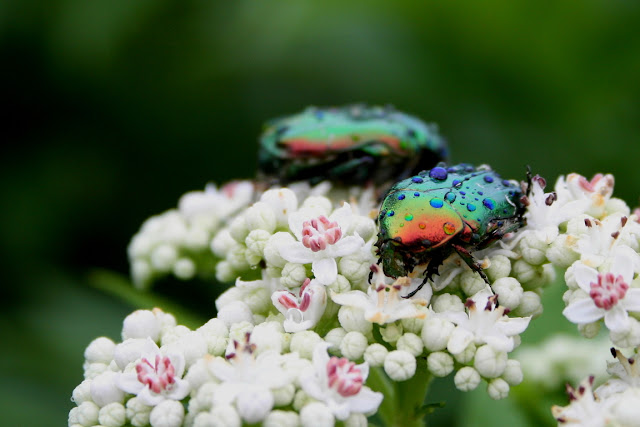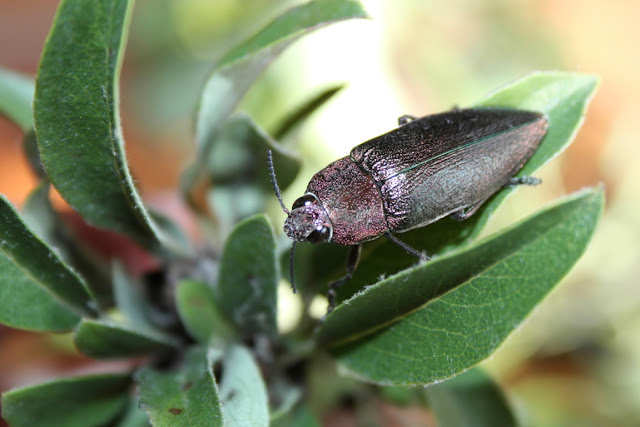Greece - June 2015
We have not let ourselves be swayed in spite of the financial crisis and made a trip to Greece again. Our target this time was Thrace near to the turkish border in the north-eastern part of the country. In contrast to the Peloponnese or Crete we did not met so much tourists and found some very lonesome places and beautiful natural landscapes.
We have not let ourselves be swayed in spite of the financial crisis and made a trip to Greece again. Our target this time was Thrace near to the turkish border in the north-eastern part of the country. In contrast to the Peloponnese or Crete we did not met so much tourists and found some very lonesome places and beautiful natural landscapes.
 |
Arrival at Thessaloniki airport. 20 °C, 30 mm/h - unfavorable weather for humans and beetles. |
We left Halkidiki. Our first stop on the road into direction of Kavala was next to a simple field and the weather becomes much better. |
Malva sp. with mines of Trachys ahenatus Musant & Rey, 1863. |
Trachys ahenatus Mulsant & Rey, 1863 on the leaves of its hostplant.
|
We arrived to the great Nestos river. Some sun-exposed bushes of Prunus spinosa L. were interesting. |
Agrilus macroderus Abeille de Perrin, 1897 flied around.
|
In the near of the Nestos river we spent the night and had a nice sunset.
|
 |
We wake up next morning and the day started with rain again. Some Cetoniidae wait for the sun.
|
Hours later the rain stopped and we found an orchard. Chalcophorella stigmatica (Schönherr, 1817) sat on Pyrus amygdaliformis Vill. |
Prunus persica L. is one of the hostplants for the following common species of Jewel Beetles.
|
Numerous Capnodis tenebrionis (Linnaeus, 1761) sat on these trees. |
We arrived to the town Alexandroupolis near the turkish border. A meadow with Rumex sp. was our first collecting place at this day. |
A common Jewel Beetle can be found on or next to this plants. Capnodis tenebricosa (Olivier, 1790). |
The mountainous region in the north of Alexandroupolis with beautiful oak forests.
|
A typical species of the Jewel Beetles for this landscape is Acmaeodera degener ssp. quattordecimpunctata (Villers, 1789). |
Rhus coriaria L. grew on stony ground.
|
Capnodis porosa (Klug, 1829) could be found on the branches and sometimes on the leaves. |
Yellow flowers are always attractive for a lot of species of Jewel Beetles.
|
One of them is Anthaxia diadema (Fischer von Waldheim, 1824).
|
Another species living in oaks is Meliboeus fulgidicollis (Lucas, 1846).
|
Loranthus europaeus Jacq. is hostplant exclusively for Agrilus kubani Bílý, 1991. Only the typical holes in dead branches could be found. |
Acmaeodera brevipes Kiesenwetter, 1858 can be found often on pink flowers like Convolvulus sp. or Malva sp. |
Anthaxia hungarica (Scopoli, 1772) is a very common Jewel Beetle. Hostplants are different kind of oaks. Adults visiting white and yellow flowers. |
Unspectacular Prunus dulcis L. near the road. Sometimes such places are very interesting. |
Agrilus roscidus Kiesenwetter, 1857 could be found on the leaves.
|
Pinus halepensis Mill.
|
Colourful flowers grew in the near including white Umbelliferae.
|
Anthaxia mundula Kiesenwetter, 1857 was typical for this place.
|
Acmaeoderella mimonti (Boieldieu, 1865).
|
We arrived to the town Soufli. - The most eastern place on this journey.
|
The sun-exposed Convolvulus arvensis L. is hostplant for a small Jewel Beetle.
|
Its presence can be recognize by its mines with the typical black eggs.
|
Trachys puncticollis ssp. rectilineatus on its hostplant.
|
We discovered the surroundings of the town Soufli near the turkish border and found this nice meadow with a lot of different kind of flowers. |
Dianthus sp.
|
Sphenoptera laportei Saunders, 1871 often hiding if somebody come.
|
Sphenoptera laportei Saunders, 1871 sat on Dianthus sp.
|
Xerothermic grassland in the Dadia forest.
|
Carex cf. flacca Schreb.- hostplant of the following species. |
Aphanisticus pusillus (Olivier, 1790) make mines within the leaves.
|
Centaurea diffusa (Lam.) could be found at dry and stony places.
|
It is the hostplant of Sphenoptera jugoslavica Obenberger, 1926 which sat on the plant or runs on the ground next to it. |
Pyrus communis L. can be seen next to the roads.
|
Big holes in the trunks are a sign for...
|
 |
...big beetles - Chalcophorella fabricii (Rossi, 1792).
|
I've been watching you!
|
Back again at Nestos river we spent some time near the river. With much luck fresh branches of Juglans regia L. could be found. |
Rare species like Chrysobothris leonhardi Obenberger, 1916 flied around these twigs.
|
Last stop before we went back home. Limenitis cf. reducta (Staudinger, 1901) said goodbye to us. |
